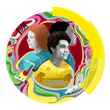Investigate the spread and treatment for infectious diseases
This activity should take approximately one hour to complete in full. It was initially created for 11–14 year-old learners but can be adapted when teaching infectious diseases to other age groups. Use the resource in a sequence of timetabled lessons, science clubs or as part of an activity day.
Learning objectives
- Explain how infections spread between humans.
- Describe some methods of preventing and fighting infections.
Guidance notes
Introduce the concept of infection using the notes on slide 3 of the PowerPoint and find out what the learners already know.

This resource was developed as part of the Chemistry for All project. The project was set up to explore and address barriers to participation in UK chemistry undergraduate study through a longitudinal project. Read the findings relevant to teachers, outreach providers, education policymakers and parents in the summary report, or download the full research report.
In Activity 1, learners will model the spread of infection. Learners will be assigned a numbered cup each containing 50 mL of liquid (one cup will have 1M hydrochlric acid while the rest will all contain water) and will follow the instructions for mingling from their student workbooks. After interacting, students will use universal indicator to determine the source of the ‘infection’ and discuss its spread.
Activity 2 is a card sorting activity. Learners have to read the information and pair infectious diseases with their treatments. While this activity is in progress you can also pass around a ball covered in UV powder from the Germaglo kit. Once learners have completed the card sort, ask them to share their answers and explain the treatments. If you used the ball from the Germaglo kit, reveal the UV powder with the torch and ask learners to reflect on how easily, and unknowingly, germs spread.
Find the answers to the activities in the teacher notes and slides.
Health and safety
Read our health and safety guidance and carry out a risk assessment before running any live practical.
More resources
- Review your 14–16 learners’ understanding of acids and bases with student worksheets, available with or without scaffolding, and teacher guidance with answers.
- Use this 15-minute microscale experiment to familiarise learners with acids, alkalis, pH and universal indicator.
- Develop your 14–16 learners’ maths skills to find the reproduction number, R0, for an infectious disease using the Disease detective resource.
Careers
The Chemistry for All project found that recognising the value and importance of chemistry, and appreciating how chemistry can lead to interesting and well-paid jobs strongly related to learners’ future aspirations. Discover how chemistry can prepare learners to pursue apprenticeships, university courses and vocational routes, or browse job profiles and try our career options game from A Future in Chemistry.
Link the context of the infection resource to careers by sharing Tyler’s job profile. She is a university laboratory technician apprentice who supports students with their research into infectious diseases, such as Covid-19 and long-term lung diseases. You can also highlight pharmaceutical careers by watching Holly’s video job profile. She is an associate scientist specialising in pharmaceuticals and works on the development of new medicines to treat diseases.
Find more activities like this, plus longer projects suitable for off-timetable days, science lessons or clubs on our Outreach resources hub.
Downloads
Infection student workbook
Editable handout | Word, Size 0.47 mbInfection student workbook
Handout | PDF, Size 0.43 mbInfection teacher notes
Editable handout | Word, Size 0.92 mbInfection teacher notes
Handout | PDF, Size 1.12 mbInfection technician notes
Editable handout | Word, Size 0.47 mbInfection technician notes
Handout | PDF, Size 0.41 mbInfection presentation slides
Presentation | PowerPoint, Size 1.42 mbInfection presentation slides
Presentation | PDF, Size 0.88 mb
Additional information
This resource was originally developed by the University of Reading to support outreach work delivered as part of the Chemistry for All project.



















No comments yet